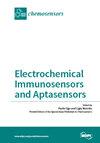Controlled Insertion of Silver Nanoparticles in LbL Nanostructures: Fine-Tuning the Sensing Units of an Impedimetric E-Tongue
IF 3.7
3区 工程技术
Q2 CHEMISTRY, ANALYTICAL
引用次数: 0
Abstract
Silver nanoparticles (AgNPs) possess unique characteristics ideal for enhancing device sensitivity, primarily due to their high surface-to-volume ratio facilitating heightened interaction with analytes. Integrating AgNPs into polymers or carbon-based materials results in nanocomposites with synergistic properties, enabling the detection of minute changes in the environment across various applications. In this study, we investigate the adsorption kinetics of AgNPs within multilayered layer-by-layer (LbL) structures, specifically examining the impact of AgNPs concentration in the LbL film formation that is further explored as sensing units in an impedimetric microfluidic e-tongue. Although absorption kinetic studies are infrequent, they are crucial to optimize the AgNPs adsorption and distribution within LbL structures, significantly influencing upcoming applications. Through systematic variation of AgNPs concentration within identical LbL architectures, we applied the films as sensing units in a microfluidic e-tongue capable of distinguishing food enhancers sharing the umami taste profile. Across all tested scenarios, our approach consistently achieves robust sample separation, evidenced by silhouette coefficient, principal component analyses, and long-term stability. This work contributes to exploring controlled nanomaterial-based developments, emphasizing the importance of precise parameter control for enhanced sensor performance across diverse analytical applications.银纳米粒子在 LbL 纳米结构中的可控插入:微调阻抗电子舌的传感单元
银纳米粒子(AgNPs)具有独特的特性,是提高设备灵敏度的理想选择,这主要是由于它们的高表面体积比有利于增强与分析物的相互作用。将银纳米粒子整合到聚合物或碳基材料中会产生具有协同特性的纳米复合材料,从而能够在各种应用中检测环境中的微小变化。在本研究中,我们研究了 AgNPs 在多层逐层(LbL)结构中的吸附动力学,特别考察了 AgNPs 浓度对 LbL 薄膜形成的影响,并进一步将其作为阻抗微流控电子舌的传感单元。虽然吸收动力学研究并不常见,但它们对优化 LbL 结构中的 AgNPs 吸附和分布至关重要,并对即将到来的应用产生重大影响。通过系统地改变相同 LbL 结构中的 AgNPs 浓度,我们将薄膜作为传感单元应用于微流控电子舌,该电子舌能够区分具有鲜味特征的食品增味剂。通过剪影系数、主成分分析和长期稳定性,在所有测试场景中,我们的方法始终能够实现稳健的样品分离。这项工作有助于探索基于受控纳米材料的开发,强调了在各种分析应用中精确控制参数对提高传感器性能的重要性。
本文章由计算机程序翻译,如有差异,请以英文原文为准。
求助全文
约1分钟内获得全文
求助全文
来源期刊

Chemosensors
Chemistry-Analytical Chemistry
CiteScore
5.00
自引率
9.50%
发文量
450
审稿时长
11 weeks
期刊介绍:
Chemosensors (ISSN 2227-9040; CODEN: CHEMO9) is an international, scientific, open access journal on the science and technology of chemical sensors published quarterly online by MDPI.
 求助内容:
求助内容: 应助结果提醒方式:
应助结果提醒方式:


